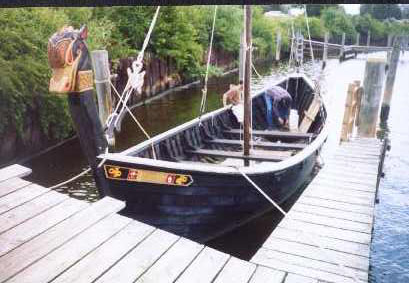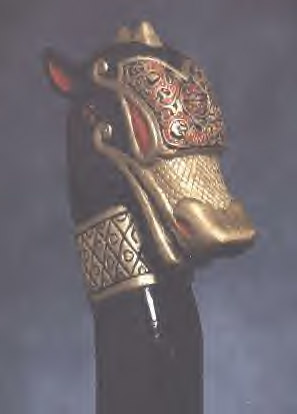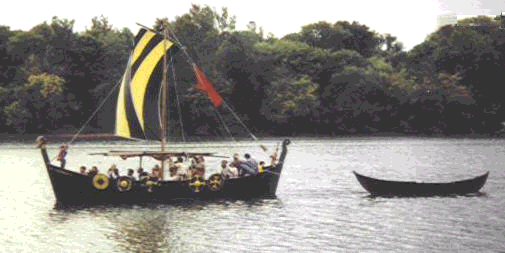

The Fyrdraca was the Longship Company's primary reconstruction Viking ship for over two decades. She was based on the Ralsweig/Rugen II Viking longship wreck found off the island of Rugen, Germany in the Baltic Sea. She was 32 feet long and could run under sail or with up to 12 oars. With her black lapstraked sides, her dragon head (Ivan), and large square sail (which qualified her as a Class A (now A - Div. II) tallship, she was an impressive sight.

After almost 25 years, the Fyrdraca's age began to show, and she was judged no longer seaworthy. Due to the sentimental attachment Longship Company members had to the Fyrdraca, there was reluctance to break her apart to salvage fittings and hardwood that had considerably more value than she had as a vessel at that point. So, instead, she was sold prior to delivery of the Sae Hrafn, and has gone to spend her final days on shallow inland waters in Missouri. Ivan, however, remained behind (perhaps unwilling to be parted from Chessie, the sea serpent reputed to inhabit Chesapeake Bay and its estuaries...), and still occasionally makes appearances at Longship Company events
The Fyrdraca was taken on a voyage approximately twice a month during the summer and autumn. Most voyages occured on the Patuxent River or other streams and inlets near Solomon's Island, Maryland. Occasionally, the Fyrdraca was towed or trailered to another area, such as Annapolis, Baltimore, Jamestown, and even as far as Newfoundland, for voyages that took place in those areas.

Activities ran from casual day trips and training voyages, to trips involving schools or Scouts, to voyages in full medieval gear and clothing for waterfront festivals, movies and photography sessions. Occasionally, a voyage of two or more days would be held. Most voyages were performed under sail, though docking maneuvers were performed under oar power. The purpose of these voyages was to research the techniques of squarerigged ships and how they differ in handling from modern sail ships. The voyages were also used to teach the rigging of a Viking longship, the handling of a squaresailed vessel, the handling of the ship under oars, rowing commands, seamanship, Viking and nautical terminology, and Viking history, as well as to enhance awareness of Viking history, including their voyages to Noth America, among the general public.
Yearly the Fyrdraca's outer hull was scraped free of flaking paint and barnacles. Her thwarts and inner hull were sanded and oiled. Her mast and yard were painted with wood preservative. Her strakes were recaulked. Needed repairs were made. Her outer hull was repainted with bottom and marine paint. The trailer and the rigging lines (ropes) were checked and repaired or replaced as necessary. These activities generally took place at work parties scheduled once or twice a month during the months the Fyrdraca was out of the water. In good weather, these activities took place at the boatyard where the Fyrdraca was kept some years, or at a convenient barn in St. Mary's County. Repairs to the Fyrdraca needed while she was in the water were performed as soon as possible. Generally these repairs were either sanding and oiling the thwarts again, or beaching and careening the boat to recaulk a bad seam.
Return to the MAIN
MENU